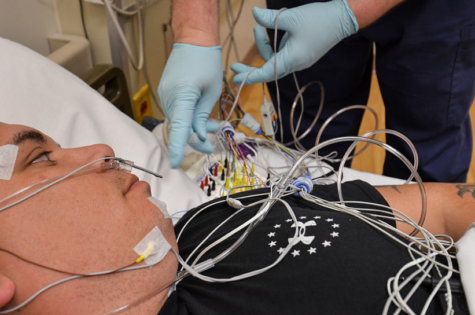Scientists Working to Crack Code of Lucid Dreaming
March 2, 2017
Most people won’t remember their dreams, but some are able to live in them.
Lucid dreaming is the act of being aware that you are dreaming, and in many cases, it also means the ability to control your dreams. It is a phenomenon that seemingly many people know of, but not many people know how or why they occur. It may even take experiencing it for yourself to really understand the world of lucid dreaming. Scientists have been working for decades to unlock the mechanism that controls dreaming in the human brain.
According to Pete Steelman, a Hershey High School psychology teacher, there is no known difference between which parts of the brain control normal versus lucid dreaming. He said that the pons of the brain stem are responsible for dreaming, but many other parts of the brain are active during the dream state.
The first scientific observations of lucid dreaming, according to World of Lucid Dreaming, was in 1975 when Dr. Keith Hearne observed several lucid dreaming subjects. In a normal dream state, one can not make any signals, but it was observed that the subjects consciously made a signal in their dream that showed that they were aware of the fact that they were dreaming.
Since then, many scientists have performed experiments, and many have found the same increased brain activity in their subjects. Psychologists have begun studying lucid dreaming.
Beverly D’Urso is a lucid dreaming researcher who has been able to lucid dream herself since she was seven years old. She has recorded her lucid dreams and has carefully observed the ways in which she is able to control her dreams.
In an interview with Psychology Today, she explained that lucid dreaming is all about paying attention to details and being aware both in dream and non-dream states.

“When you see things that don’t fit, that’s a clue that you’re dreaming,” D’Urso said, “to facilitate the process you can form the habit of examining the environment or your state of awareness during the day.”
She has not only been able to eat fire and fly to the sun in her lucid dreams, but she has been able to overcome obstacles that she wasn’t able to overcome when not in a dream state. Her struggle with writer’s block has been conquered ever since she forced herself to sit at her computer in her dream.
“And slowly—like in slow motion—I got to the computer,” D’Urso said, “the seat had a hole leading down to hell. It was very scary but I sat down and let myself fall into this pit in hell—and then I woke up.”
Recollections of lucid dreams have been recorded for several years now. Many people, including some HHS students, are able to lucid dream, and remember what they dreamt about as well as how they did it.
Junior Dante Falcucci said that his first lucid dream happened at a friend’s house and totally by accident.
“I woke up when I thought I heard my friend call my name,” Falcucci said. “At first I was scared when I realized I couldn’t move but then I remembered that I read somewhere that it could possibly be a lucid dream.”
A similar situation happened for sophomore Alexander Elchev during his move to a new house.
“We were moving from Chicago to Madison, so I dreamed about unpacking every box and organizing the house,” Elchev said, “I didn’t think much of it at the time, I just thought it was a regular dream.”
Neither one of them experienced a lucid dream the next night, but they were both instantly intrigued by what they had experienced. Both of them since their first experience have actively tried to lucid dream again.
The ways that people enter the lucid dreaming state vary from person to person, but for Falcucci, similarly to D’Urso, it’s all about increased awareness.
“From what I read it was to get into the habit of asking yourself whether it is a dream or reality and to keep a dream journal and that increases the frequency of them,” Falcucci said.
For Elchev, his lucid dreaming steps are more extensive and require darkness, an absence of technology, and heavy breathing. Only then can he concentrate on his dreaming.
“In a period of the sleep cycle when you naturally sleep lighter, I generally realize that I’m asleep,” Elchev said. “Trying not to wake up, I do some very minor tasks to make sure I can control the dream, like raise my hand or walk.”
These steps do not work every time, they both said, but their lucid dreaming frequency has increased since learning what works for them.
Everyone does something different when they’re able to control their dreams. For Falcucci, he simply enjoys walking around in his lucid dreams.
When in his lucid dreaming state, Elchev said that he likes to visualize things that challenge him in his day to day life.
“I try to focus on puzzles and issues that I’m having trouble visualizing,” Elchev said. “I’m interested in theoretical maps, and I try to visualize globes and maps nowadays.”
Lucid dreaming is different for everyone, and it’s still a phenomenon that hardly anyone can explain. However, by observing how others lucid dream, we can get a better idea of how to enter the world inside our heads.







